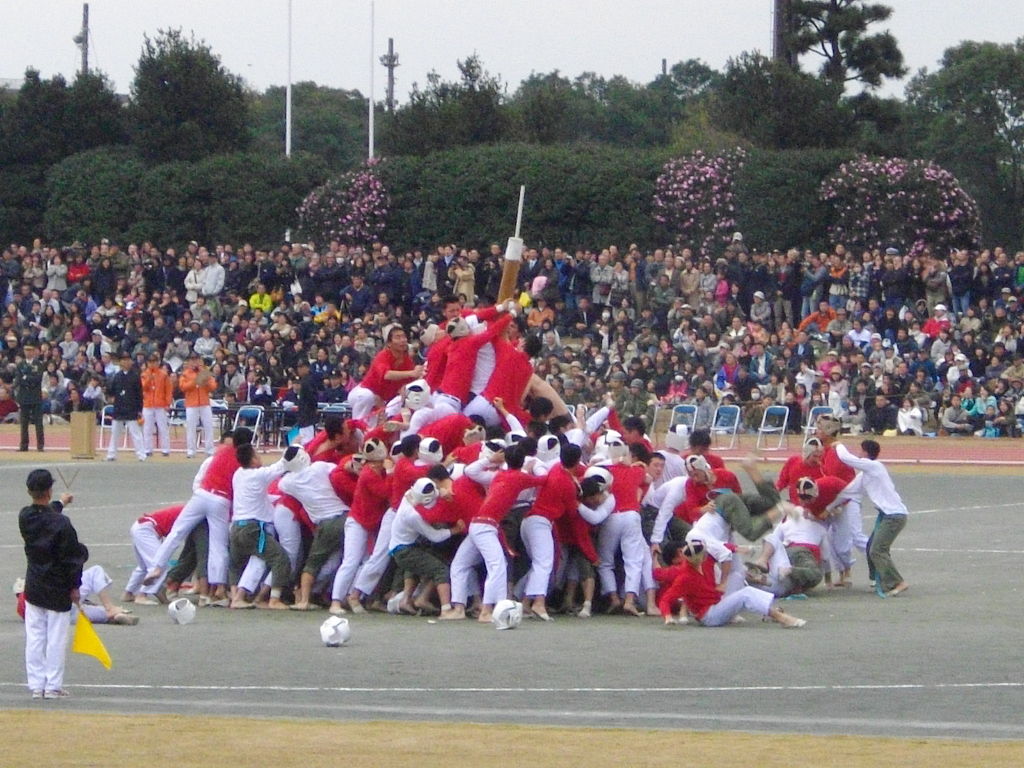The Most Dangerous Pole Dance

There’s a lot going on in the picture above. Roughly 150 young men are gathered, half in red shirts with white pants, the other half in white tops and green pants. Most are wearing helmets, although the helmets don’t seem to be well-fastened; there are at least three headless ones sitting on the ground. Also sitting on the ground, behind a person holding a yellow flag, seems to be one of the competitors. And then if you look closely, on the other side of the scrum, you’ll see a guy on team green pants, upside down with his feet kicking in the air.
Oh, and there’s also a big pole in the middle.
Welcome to bo-taoshi, a Japanese version of Capture the Flag — if you add in a lot of cuts, bruises, sprains, and a lot of other carnage. And the picture above? It’s the tame version.
Bo-taoshi, which literally translates to “pole toppling,” dates back about a century, maybe more. The goal of the game is simple: you have to knock down the other team’s pole. And the rules don’t add much complexity, either. There are two teams of 150 players each. Half the people from each side defend their own pole, while their remaining 75 teammates from the other side are the attackers, trying to bring down the opposing team’s 12-foot high pole. The team that brings the pole down to a 30-degree angle first wins, provided that they do so before time runs out. The picture above comes from a contest at the Kaisei Academy, a secondary school (grades 7 to 12) in Tokyo, and while the rules are simple, the gameplay itself is not. The New York Times explains:
Kaisei students spend a lot of time plotting strategy. Attackers are divided into three main groups. The first six or so try to clear a path to the pole by pushing away defenders. The second wave jumps over defenders to grab the pole. The third group pulls the legs of teammates who have grabbed the pole, hoping to lower it further. It also pulls away defenders trying to drag down teammates.
Before the whistle that starts the game, the first wave of attackers marches toward midfield in a tight-knit scrum so the defenders cannot identify who will lead the charge. This group usually includes taller students who have the greatest chance of grabbing the pole.
The defenders align in concentric circles. A first inner ring of three defenders holds the pole. Another three defenders hold the base of the pole. A third layer of eight defenders crouch with their backs to inner ring of teammates, and lock arms. The remaining defenders form a wider ring to repel attackers or pull down attackers who reach the pole.
Much of the strategy involves deciding how many attackers to throw at the pole, and in what patterns. Some teams favor a frontal assault. Others send attackers from different points around the pole. Teams videotape their practices. The strategies are kept secret, and are passed on to underclassmen.
But even with that strategy, the chaos inherent in having two groups of 150 teenage boys in a melee leads to a lot of acceptable injuries; per the Times, “sprains, cuts and bloody noses are common and accepted. Every so often, students may fracture leg bones, vertebrae and cheekbones or sustain a concussion.” And that’s the tame version of the sport. At Kaisei, they use the “safer” rules, which among other things, prevent the defenders from starting with a man positioned atop the pole. But in other contexts, that’s allowed — and strategically sound. See for yourself — here’s a video:
That video isn’t from the Kalsei Academy but from the National Defense Academy of Japan, a university-level military academy. If you watch the video — and you really, really should, as words alone cannot do it justice — you’ll note that in all three matches, both teams have a man on the top of the pole, hanging on to a thin stick protruding upward. That player, called the Ezio or Ninja, according to Tofugo, acts as a counterbalance; “if the pole is shifting to one side, it is their responsibility to counter the shifting by directing their weight to the opposite side.” Oh, and he can bark out orders to his teammates if he sees the offense exploiting a weakness, and as a last resort, he can kick attackers in the head. That happens a lot in bo-taoshi.
As a half-sport, half-military exercise, perhaps bo-taoshi makes sense, at least historically. It’s fallen out of favor over the last few decades, and outside of the two schools above, it’s increasingly rare to find exhibitions of the game — and probably won’t spread much, either.
Bonus fact: The rules probably don’t allow for it, but if bo-taoshi competitors really wanted to get a leg up — or more accurately, keep legs down — they could take a page from the Royal Sonesta New Orleans. About a half-century ago, Mardi Gras revelers in the city wanted to get up onto the hotel’s balcony, which offered a VIP view of the parade from above the crowds. While one could buy admission to the deck, there was another way in: climb up the building’s support poles. After a few years where trespassers successfully made their way to the balcony via this unanticipated entrance, the Sonesta began greasing the poles. Since then, the greasing of the poles has become an annual tradition, drawing fans from around the world.
From the Archives: Walk This Way: One Japan school’s efforts to perfect synchronized walking.
